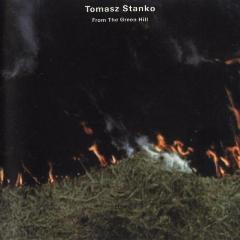Tomasz Stanko - From The Green Hill (1999)
Tomasz Stanko - From The Green Hill (1999)

1 Domino
2 Litania play
3 Stone Ridge
4 ...y despues de todo
5 Litania
6 Quintet's Time
7 Pantronic
8 The Lark In The Dark
9 Love Theme from Farewell to Maria
10 ..from the Green Hill
11 Buschka
12 Roberto Zucco play
13 Domino's Intro
14 Argentyna
Musicians:
Tomasz Stanko - trumpet
John Surman - baritone saxophone, bass clarinet
Dino Saluzzi - bandoneon
Michelle Makarski - violin
Anders Jormin - bass
Jon Christensen – drums
After his critical and popular success with Litania, revitalizing the music of his countryman Komeda, Poland's Stanko, possessor of perhaps the darkest trumpet sound in jazz, resurfaces here in quite a different context, with associates from everywhere. Bandeonista from Argentina, reedman from England's south coast, classical violinist from Detroit, bassist from Sweden. Only veteran Norwegian drummer Jon Christensen is retained from the Litania session, although a sense of continuity is maintained by Saulzzi, who brings a wistful regret to his interpretation of a Komeda theme. Otherwise Stanko and John Surman share composer credits as well as the special understanding that belongs only to the most lyrical improvisers. –ECM
From the Green Hill is Tomasz Stanko's ECM follow-up to the deservedly acclaimed Litania - The Music of Kryzsztof Komeda. The Polish composer and trumpeter (and former Komeda sideman) teams up with countrywoman Michelle Makarski, ECM stalwarts saxophonist John Surman, bandoneon king Dino Saluzzi, drum god Jon Christensen, and bassist Anders Jormin. The set is comprised mainly of Stanko originals, but there are also compositions by Surman, and two by Komeda, including "Litania." This chamber jazz sextet draws heavily on European jazz influences naturally, but also from Eastern Europe's folk traditions. In this way, Komeda's influence is clearly felt throughout the recording, even on Surman's "Domino." But it is also fair to say that Stanko was there with Komeda at the beginning, and his devotion to the folk traditions of his region had an equally big impact on the late composer though both men were firmly committed to the jazz idiom as the only means of expression for their kind of music. Both men sought to identify the music their group played with their homeland and Eastern Europe. Interestingly, this notion brings out the international aspirations of each musician on the date. On "Litania," Saluzzi moves the interval enough to shift the melody to make it an Italian funeral song. With "Stone Ridge," that follows, Makarski opens Surman's piece with a wistful Hungarian lilt in her violin line, before Stanko's muted trumpet and Surman's bass clarinet wind around each other in a slower than slow counterpoint that brings in Saluzzi's bandoneon with the melody. It's an old modal-sounding piece, which is narrow in its dynamic range but rich in texture and nuance before it turns itself into a gypsy polka. Surman tries his hand at some Dave Tarras klezmer lines on the big clarinet, and the piece evolves again into a post-Miles jazz vamp. Christensen is without doubt the greatest drummer in ECM's regular stable -- yes, that includes Paul Motian. His style is one of the unobtrusive percussionists. He plays like crazy, elegantly weaving and sweeping through the band's changes and never once stutters or, as so many drummers are wont to do, draws any attention himself. His humility is truly remarkable for a percussionist of his caliber. On Stanko's "Love Theme From Farewell to Marie," a blues tune in A minor, Stanko plays with the rhythm section for a bit before Makarski weaves her way in a knot at a time, and Jormin creates a harmonic bond with her. When Saluzzi starts to fill out the changes, he shifts the architecture of the tune so that when Surman slips in, the tone and mode -- let alone the rhythm of these blues -- has become darker, deeper, and mellifluous in its timbral richness and harmonic elegance. Over 14 tunes, Tomasz Stanko reveals once again why he is a bandleader of great authority and integrity. This is an ensemble of powerful individuals and no less than three composers among them. Stanko's arrangements are carried out with equanimity and grace as well as precision and musicality. The result is an album that, while not as attention grabbing as Litania, is as musically inventive and challenging as its predecessor, and wholly more satisfying than most of what comes from Eastern Europe in the name of jazz at the end of the 20th century. ---Thom Jurek, allmusic.com
Po docenionej przez krytyków i publiczność „Litanii”, ponownie odkrywającej twórczość Krzysztofa Komedy, Stańko, najmroczniejsza chyba trąbka jazzu, pojawia się tu w innym kontekście – z muzykami z najróżniejszych stron świata. Bandoneonista z Argentyny, reedman z południowych wybrzeży Anglii, skrzypaczka grająca klasykę z Detroit, kontrabasista ze Szwecji. Z zespołu, który brał udział w nagraniu „Litanii” pozostał norweski perkusista Jon Christensen. Jednak ciągłość z poprzednim albumem Stańki zachowuje również Saluzzi, który przywołuje jeden z słynnych tematów Komedy nadając mu melancholijny, tęskny ton. Na album składają się kompozycje Stańki i Johna Surmana. Czuć między nimi wyjątkowe porozumienie właściwe jedynie najbardziej lirycznym improwizatorom.
download (mp3 @320 kbs):
yandex 4shared mediafire cloudmailru
Last Updated (Monday, 30 July 2018 17:21)
